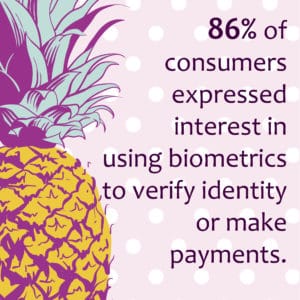Password usage to safeguard sensitive data is becoming obsolete. Is biometric authentication the solution to all of our password woes?
Try to think of all of the passwords you have to use on any given day. How many for work? For personal accounts? Online shopping and ordering? Social Media, banking, email, device locks; the list of passwords needed these days is basically endless. Which makes remembering all of them virtually impossible. Maybe you have a password book. Or a password manager. Or you just leave post-it notes all over your workstation and hope for the best. Whatever your system, we can all agree that it’s probably not working.

For something like unlocking your mobile device, one solution to the unending password issue came with Apple’s introduction of their Touch ID. Built into the home button, this technology meant that your fingerprint was now the key to getting into your device, rather than entering a password. In the years since, the fingerprint scanner has been increasingly integrated with the iPhone’s numerous processes. From serving as the sign-in to download apps or music to unlocking apps like banking, ecommerce, etc., the Touch ID has helped. However, this solution is not without passwords. Each application for the Touch ID is limited, meaning that after so many Touch logins you have to type in the password. Which brings us back to the issue that most consumers are hitting into: we have too many passwords.

Password Failures
Passwords are far from a new or revolutionary concept. For as long as there have been secrets or secure pieces of information, there have been passwords. In fact, most of our personal, sensitive data is somehow tied to a password in one way or another. What is a social security number if not a sort of password for your identity? And given this prevalence of password usage, the increase in data breaches have resulted in passwords losing consumer trust.
With numerous headline-grabbing breaches in 2017—most notably Equifax’s—consumers are increasingly worried about their secure personal and financial data being linked to numbers or passwords. As a result, the demand for a biometric-based solution is on the rise.
“Everyone knows they have to move away from knowledge-based authentication,” explained Mark Nelsen, Visa’s SVP of risk products and business intelligence, in an interview with PYMNTs. “It’s not sustainable.”

Between consumer demand, increasing concerns over password-centered security, and current technology innovation, it’s hard to understand why we don’t have more comprehensive biometric-based options in place yet.
Biometrics Takeover
According to a recent study by Visa of 1000 Americans, the majority of consumers are not only familiar with biometrics but are eager for its implementation on a wider scale. The survey focused on using biometric authentications, such as fingerprints and facial and voice recognition, to unlock accounts and simplify payments. 86% of consumers surveyed expressed interest in using biometrics to verify identity or to make payments and over 65% stated they are already familiar with using biometrics for both convenience and added security.
So why haven’t we switched? For starters, it’s going to be a long, expensive road to biometrics after decades of knowledge-based verification. Modern banking and payments center on passwords—from our initial identification via SSNs to our account numbers to our PINs—which means switching to biometrics is essentially rebuilding the entire infrastructure.

There is also the issue of advancing the technology to a secure enough place. With any new tech, there is always a high chance of gaps in protection and new, unexpected ways of breaking through.
This isn’t to say that the biometric shift isn’t well underway. From facial recognition being used for added security and speed at the 2020 Tokyo Olympics to ordering takeout via facial recognition kiosks at quick service restaurants, biometric authentication will undoubtedly come to redefine how we do business. It’s more a matter of “how long until this happens” than “will this happen.”
Where Do We Go from Here?
The shift to biometrics may be a slow one, but it’s certainly one that’s coming. As consumers continue to become more comfortable with biometric verification via their mobile devices, the use will surely spread across all industries as a more safe and secure means of verifying transactions and data of all kinds.

